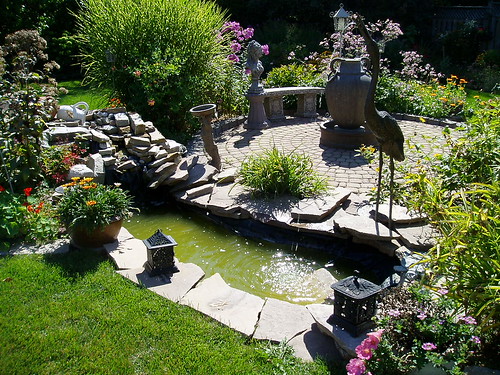 Garden Landscaping by rainbow_landscaping
Garden Landscaping by rainbow_landscaping
Because TheGardenLady has been asked about landscaping and/or choosing a good landscaper, TheGardenLady thought this would make an interesting column.
Below are a few suggestions for anyone who is interested in landscaping one’s property. There are many outstanding female landscapers as well as male landscapers. (The word “he” was used most of the time in this post just to make the writing of this column easier.)
Make sure you know your property or do what is called a site analysis. Know where North, South, East and West are on your property. This is important because some plants prefer to get morning or evening sun and light. And when you plant, you want plants that will be happiest in a location. You want roses? They want sun, sun, sun; but some varieties will take just 5 hours of sun. So if you write down notes to yourself telling exactly how much sun a spot gets, this will be very helpful in your planning. Know existing conditions on your property such as hills, or areas of elevation and if you have good or bad drainage. You may want to try to eliminate the problem or work with it.
Know the Temperature Zone in your area. Even within one state, there might be different Temperature Zones. Plants that grow in the Northern part of the United States might be unhappy in the South and vice versa and some plants might grow in a broad range of climates. A clematis that grows in Zone 9 or 10 won’t live outdoors in the winter in Zone 6. Or you might want a cactus garden, but if you live in NJ, it is trickier to plant cactus than it would be in Arizona. Yet there are some cactus that will survive in NJ, even in NJ winters. So be sure to check your temperature zone and be sure that when you buy plants, you buy plants that will survive and thrive in your area. See here.
Most people want plants that are easy to raise in your area, but if you like a challenge like Wayne Daniels in California who raises tulips where they usually don’t grow (see here) you have to know the needs of the plants in order to accommodate them in your area.
Have your soil tested. I cannot stress the importance of soil testing. And I really recommend using your local Master Gardening chapter or your local extension office. When you get it tested, get different areas where you want to plant different things tested in separate tests. For example, if you want a vegetable garden, test that area separately from an area that you might want to plant lawn. The tests will then send you back information for what to amend the exact amount for that need. Though the tests might cost a few more dollars than a soil kit you can buy in a store, you will get a thorough readout of what you have and what you need to amend your soil. And visiting the Master Gardeners with your questions and or problems is FREE. They will even explain your soil test results if you want – for FREE.
Examine your property and note what conditions there are. Note existing conditions on your property like hills, or bogs or areas of elevation and if you have good or bad drainage. Do you have walls blocking the sun or making a micro climate that might be hotter than the rest of your property? Are there trees? If so what types of trees are on your property? Few plants will thrive under nut trees and if you want perennials under the nut trees, be sure you get those plants that will live near a nut tree. You will also note, by the size of the trees or how large they can grow, how expansive a root mass it has or will get.
Locate wet or dry sites on your property to know what will live – for example land near a blacktop driveway or roadway may give off too much heat for some plants and might also be salted to remove snow – plants cannot tolerate excessive salt. And you would need different types of plants for under your rain spout.
Know your site boundaries and where the house is located on your property. When you are designing your landscaping, consider the views from both inside your house looking out as well as how the plants will look outside your house. You might even want to consider your neighbor’s house when you plant. Do you want your neighbor to see your beautiful plants from his house? Or do you want to make a hedge so you and your neighbor can’t see each other’s house?
Check your soil consistency. You want soil that is friable, not compacted or if you live in a sandy area, you want to know what can grow in that type of soil. You can always amend the soil with the compost TheGardenLady knows you are saving.



